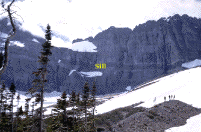
Questions
For some of the following questions you will need an atlas. The following map may help.
At about 30 degrees N latitude (Houston), the longitude of the mid-Atlantic spreading center is about 45 W longitude. What is the direction of the NA plate at this boundary? What is the velocity?
The western boundary of the NA plate is about 120 W longitude at about 30 degrees N latitude. What are the velocity and direction of the NA plate at this location?
Generalize .... what happens to the direction of the NA plate and its direction of movement going from its eastern to its western boundary at 30 degrees N?